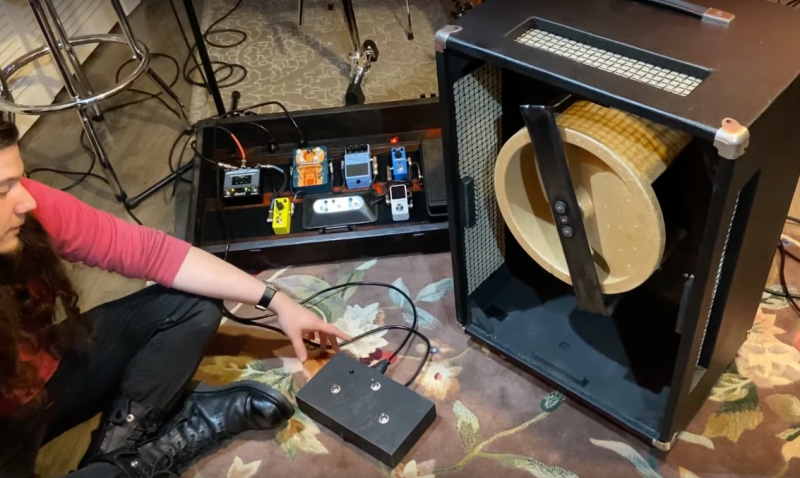Modern musicians may take for granted that a wide array of musical instruments can either be easily connected to a computer or modeled entirely in one, allowing for all kinds of nuanced ways of creating unique sounds and vivid pieces of music without much hardware expense. Not so in the 1930s. Musicians of the time often had to go to great lengths to generate new types of sounds, and one of the most famous of these was the Leslie speaker, known for its unique tremolo and vibrato. Original Leslies could cost thousands now, though, so [Levi Graves] built a modern recreation.
The Leslie speaker itself got its characteristic sound by using two speakers. The top treble speaker was connected to a pair of horns (only one of which produced sound, the other was used for a counterweight) on a rotating platform. The second speaker in the bottom part of the cabinet faced a rotating drum. Both the horns and drum were rotated at a speed chosen by the musician and leading to its unique sound. [Levi] is actually using an original Leslie drum for his recreation but the sound is coming out of a 100-watt “mystery” speaker, with everything packaged neatly into a speaker enclosure. He’s using a single-speed Leslie motor but with a custom-built foot switch can employ more fine-tuned control over the speed that the drum rotates.
Even though modern technology allows us to recreate sounds like this, often the physical manipulation of soundwaves like this created a unique feeling of sound that can’t be replicated in any other way. That’s part of what’s driven the popularity of these speakers throughout the decades, as well as the Hammond organs they’re often paired with. The tone generators on these organs themselves are yet another example of physical hardware providing a unique, classic sound not easily replicated.















Ah, Leslie speakers, takes me back. Never could afford one myself but had use of one for a while with my guitar. Personally I enjoyed the video. The revisioning is appealing and the presentation laid back but enthusiastic.
The article also got me thinking about my other dream speaker of bygone days, for conventional listening, , the Linn Sara. And now I have a soulless earbuds, soundbars and headphones. At least the latter has cat ears.
For real lmao what the heck
Ah, Leslies. Generally fond memories. Such a bear to lug around on gigs… Especially to clubs upstairs.
In a studio I worked at in the 70s we placed a Leslie in the basement of this 1890s built building with mics at varying distances from it. Speed control snaked to the control room. Created wonderfully nuanced, controllable, echo chamber sounds. Unfortunately the damp basement took a toll on the cabinet but the speakers and rotor held up remarkably well.
I’m familiar with Leslies that rotate on a vertical axis, but they are kind of huge. I guess to fit in an organ against a wall , spinning on a horizontal axis would make sense.
Building one has been on my to do list for years. I think the vertical axis design would be simpler to build though, but I’ll keep this in mind.
I too am QUITE familiar with Leslie speakers! There was a time that I hauled around 4 of them, with a B3, a Fender Rhodes, a Prophet 600 and a Pro One! Now, I use two Motion Sound “Leslies”, one for the lows and one for the highs, usung a Ferrofish module. And I can carry them in each hand at the same time! Still, I did keep two of the 122’s and the B3, just in case!!!!
I have wanted to make a small version (like 4-6″ or so) for a while. Had one in an organ and love the sound
Glad to see Thomas organs getting repurposed. Sad that it is not 2 speed which was for not having the random stop if single speed, instead an added bonus phase shifting before we knew what to call it.
Put 12 volts DC or so into the motor instead of AC to make it stop fast. DC brake it was called, some organs had it instead of 2 speed motors.
Yeah- that
Meant to say that the DC brake was really cool, the near instant change added an almost percussive aspect. Loved it.
For all the yapping in the video, he fails to show the sound of the speaker alone. He goes through the construction and then a band demo. But imits what it sounds like alone to hear the effect. So yeah, the video is useless.
“Rock Hard” proceeds to play softest rock ever.
no info on how to do this? No info on the control switch changing the speed of the “single speed” motor? This is more back patting than hack info…